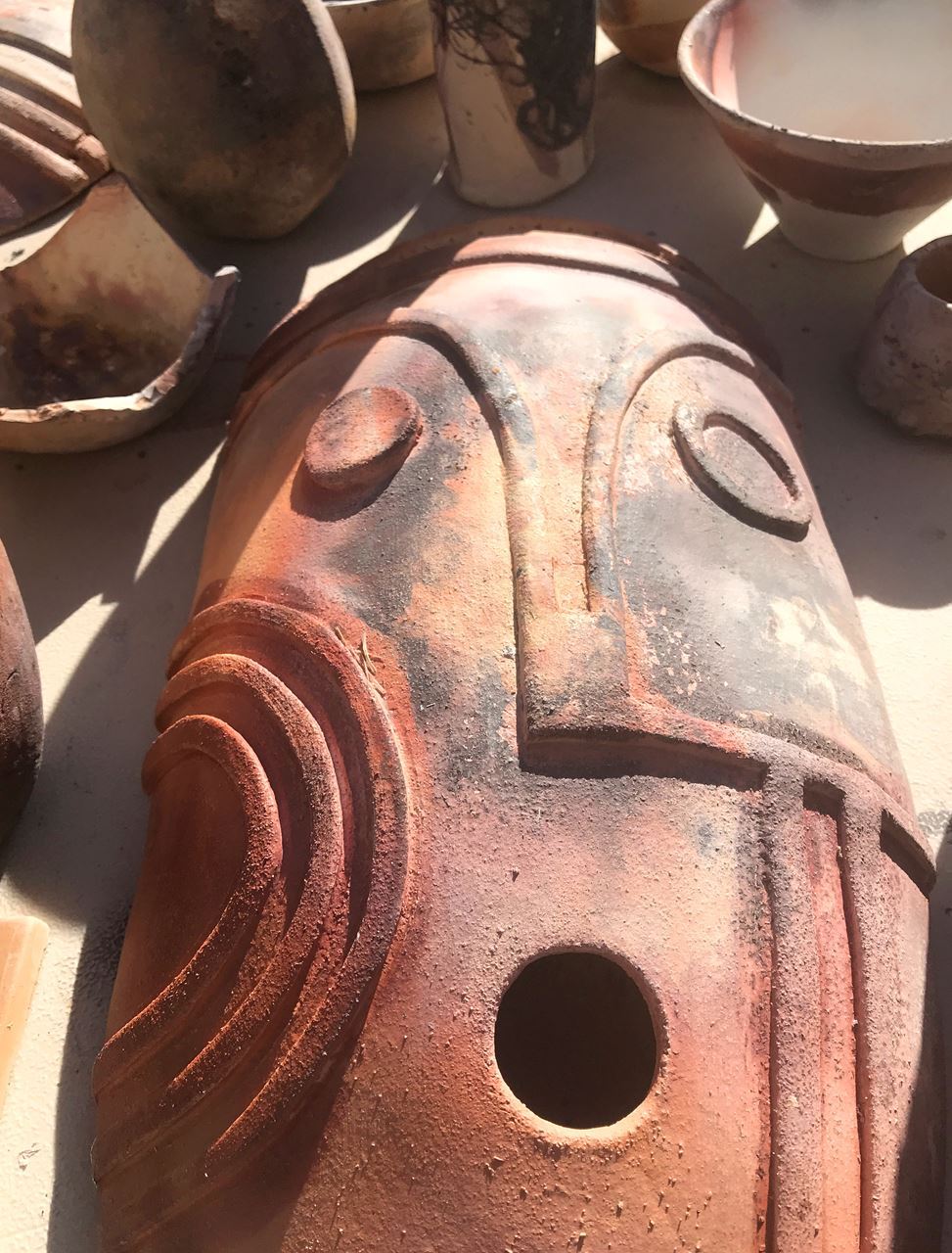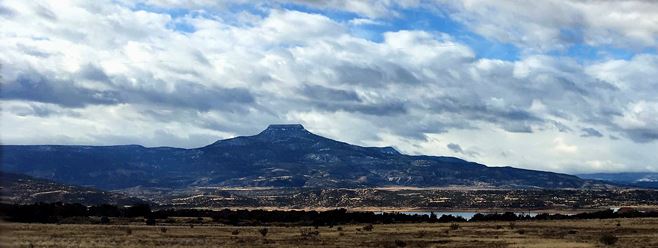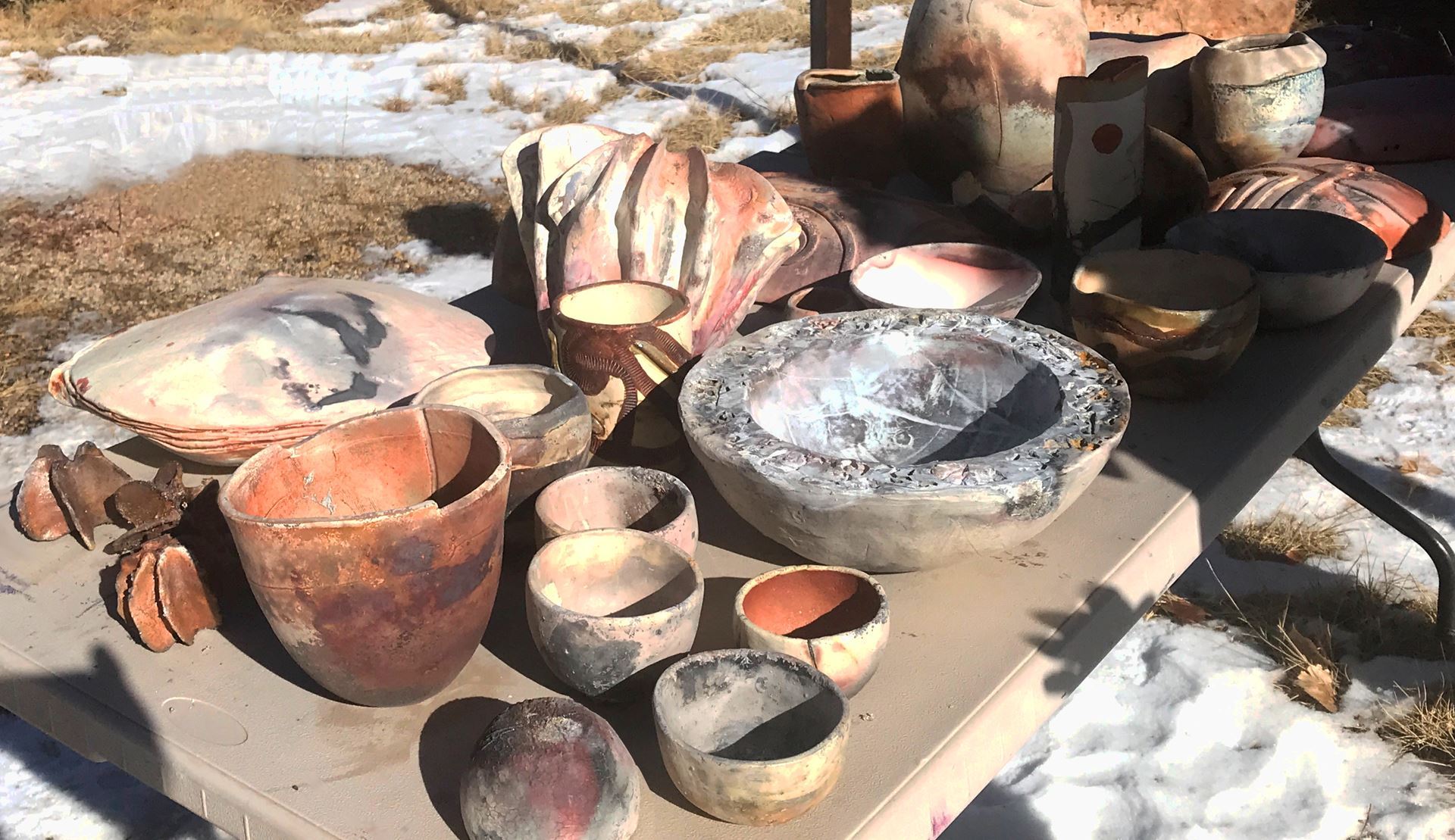 On the last day of 2019, 3 potters and one friend gathered at Ghost Ranch to start up the first firing of the moved and remodeled fume kiln at the Ghost Ranch Pinon Pottery Studio. The day was preceded by difficulties. Two weeks previous, on December 13, 7 potters had assembled at the ranch to fire the kiln. The kiln was loaded, and was intended to be fired, but problems developed and the plan was stopped. Before I finish the story, let me go back and give a short history of this kiln prior to December 2019.
On the last day of 2019, 3 potters and one friend gathered at Ghost Ranch to start up the first firing of the moved and remodeled fume kiln at the Ghost Ranch Pinon Pottery Studio. The day was preceded by difficulties. Two weeks previous, on December 13, 7 potters had assembled at the ranch to fire the kiln. The kiln was loaded, and was intended to be fired, but problems developed and the plan was stopped. Before I finish the story, let me go back and give a short history of this kiln prior to December 2019.

History of Ghost Ranch Fume Kiln
In the far reaches of history when no one can remember, Jim Kempes and Willard Spence placed hard brick in a circle on a base of cement blocks and brick. They made a lid of metal lined with refractory fiber with a hole in the middle. The original purpose and method of firing for this kiln was unknown until recently when we got this message from Jim Kempes:
Willard had the idea to build the kiln as a cheap, mid-range temp kiln. The hard bricks were inexpensive and the fiber insulation lid was new, cheap and all the rage. He came up with the cheap burner solution and we built it for two or three hundred dollars? We fired it a few times, and I do remember the temp difference with the top having to be watched. We weren’t really working at the cone six range so it sat waiting to be repurposed. Willard always loved the science of clay and wanted to use local clays and materials as glazes (perlite from the mine by Tres Piedres) and I think that was the reason behind the kiln (and dollars). It was Willard’s baby and I was the labor. Always loved working and learning with Willard. What a potter! Hope this helps.
Jim Kempes, via email, 2/2/2020
Along come Barbara Campbell and Judy Nelson-Moore who decide this kiln should be used for low-fire alternative firings…pit firing, low-fire salt, wood, propane burners, etc. Over several seasons, the NMPCA volunteer camp activities included putting fiber blanket around the kiln, adding refractory plaster and cutting burner holes in the sides. Judy had done this kind of firing in Denver in previous years in saggars and called it “fume firing” because of the atmospheric effects made by salt, chemicals and combustibles brought up to temperature. Kind of like raku, except the work is left in the kiln to cool and the reduction materials are fired with the pieces, not placed in them after the firing as in raku. Here is an article about these firings on Judy’s website. Many happy firings were done in the kiln by the NMPCA and other groups.
Then, in the summer of 2015, a flash flood washed away the Pot Hollow ceramic studio down in the Yeso Creek arroyo. The ceramic studio was rebuilt on higher ground in the Pinon building of Ghost Ranch. NMPCA volunteers carefully dismantled the still-standing Fume Kiln bricks and base, cleaned them off, moved them up to the Pinon kiln yard, rebuilt the base and kiln, reapplied the fiber blanket and plaster. Quick to say but took about 3 years. Now, at the end of 2019, it was ready to test.
Back to our story: For the initial test firing after the rebuild, people who had participated in the rebuilding of the kiln were invited to bring work. On December 13, when the kiln was loaded, there was considerable variety in the way different people “packed” their tin-foil saggars. Some added very little in the way of combustibles and chemicals on the theory that “Less is More.” Others added more material in hopes of encouraging more colorful effects. Some used ferric chloride brushed or sprayed on to achieve the red/browns. Copper, cobalt, and iron were also added. Salt in various amounts was added as table-sized crystals, dissolved in water and sprayed on, or sprinkled in the saggar. During the preparation, some of the combustible materials (grasses, shredded wood, banana peels, other natural materials) were soaked in salt and copper carbonate before being dried. All work was wrapped in 1-2 layers of aluminum foil, usually one piece per bundle. The kiln was tumble stacked with one and 1/2 shelves separating the pieces. Here are pictures of the December 13 kiln loading.
The firing of the rebuilt kiln was started up on December 31, 2019, after considerable effort to prepare the burners with help from Frank Willett and Big Jo’s Hardware. From the start, it was apparent the firing was difficult to control. The kiln jumped 300 degrees in the first 15 minutes necessitating a slow down. Started at 10:45 am, by 1:45 there was considerable fuming out the top. Slowly turning up the burners in small increments enable a temperature of 1330 by 2:15. Looking through the peep holes, it was seen that the tin foil was breaking down in the manner associated with a desirable temperature. Usually this point is reached at a temperature of 1450 or so, but the actual temperature inside the kiln was difficult to judge. Because the firing length of 3.5 hours was deemed minimally long enough and because there had been considerable fuming coming out the top, it was decided to turn the kiln off.
Unloading of the kiln was delayed until January 6 because of weather and other activities. The firing crew was joined by friends and by Ghost Ranch Jan Term students for the exciting unwrapping.
Results: The results showed considerable difference in the firing temperature top to bottom, with the top being mostly underfired and the bottom achieving too high a temperature. Work stacked along the outside edge of the shelves impeded air flow which could have added to this problem. In this firing, the “Less is more” principle did not hold, with the most color and pattern being achieved with more materials.
Conclusions: These are the conclusions of the participants:
- More materials (combustibles, chemicals) may work better
- Need more pyrometer holes to be able to judge temperature throughout kiln
- Need to rearrange bricks under the shelves to encourage more air flow through and up the kiln.
- Make a chimney, 8″, to put in the top to draw more air up.
- Make a damper for the chimney and use to control fuming.
- May need to enlarge the burner holes.
Aftermath: The people involved in the firing included Barbara Campbell, Judy Nelson-Moore, Luisa Baldinger, Cirrelda Snider-Bryan, JB Bryan, Anne Keener, Penne and Jack Roberts. Frank Willett, Barbara’s friend Tor, Anne’s husband Larry, and some of the Jan term folks gave assistance in various capacities. Even though the firing that was started on December 13 had to be aborted when the burners did not work and was not finished for almost a month, the participants felt that being able to spend an evening at Ghost Ranch in winter with a small group was a sterling experience. Everyone got to really talk to each other, listen and learn, and we all developed a great respect and liking for everyone involved. This resulted in a reunion of firing participants on February 2nd in Santa Fe to discuss the results and celebrate. These types of fun and educational experiences are why we join NMPCA!

Thank you to Barbara Campbell, Cirrelda Snider-Bryan and Penne Roberts for contributing images to this article.
by Judy Nelson-Moore



